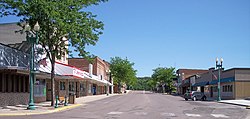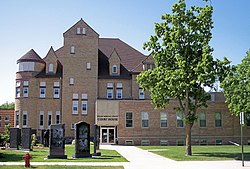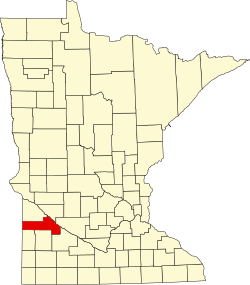2010 census
As of the census of 2010, there were 2,897 people in 1,282 households, including 747 families, in the city. The population density was 807.0 inhabitants per square mile (311.6/km2). There were 1,417 housing units at an average density of 394.7 per square mile (152.4/km2). The racial makup of the city was 89.9% White, 0.6% African American, 5.2% Native American, 0.4% Asian, 1.8% from other races, and 2.1% from two or more races. Hispanic or Latino of any race were 4.7%. [19]
Of the 1,282 households 25.7% had children under the age of 18 living with them, 44.1% were married couples living together, 10.1% had a female householder with no husband present, 4.1% had a male householder with no wife present, and 41.7% were non-families. 37.2% of households were one person and 17.2% were one person aged 65 or older. The average household size was 2.17 and the average family size was 2.82.
The median age was 43 years. 21.5% of residents were under the age of 18; 8.8% were between the ages of 18 and 24; 22.3% were from 25 to 44; 26.9% were from 45 to 64; and 20.7% were 65 or older. The gender makeup of the city was 48.4% male and 51.6% female.
2000 census
As of the census of 2000, there were 3,070 people in 1,344 households, including 806 families, in the city. The population density was 890.5 inhabitants per square mile (343.8/km2). There were 1,472 housing units at an average density of 427.0 per square mile (164.9/km2). The racial makup of the city was 92.35% White, 0.07% African American, 5.70% Native American, 0.16% Asian, 0.42% from other races, and 1.30% from two or more races. Hispanic or Latino of any race were 2.15%.
Of the 1,344 households 27.7% had children under the age of 18 living with them, 50.5% were married couples living together, 7.7% had a female householder with no husband present, and 40.0% were non-families. 35.0% of households were one person and 18.5% were one person aged 65 or older. The average household size was 2.24 and the average family size was 2.91.
The age distribution was 24.1% under the age of 18, 7.9% from 18 to 24, 24.1% from 25 to 44, 22.0% from 45 to 64, and 21.8% 65 or older. The median age was 41 years. For every 100 females, there were 86.1 males. For every 100 females age 18 and over, there were 81.2 males.
The median household income was $32,031 and the median family income was $45,536. Males had a median income of $32,905 versus $22,957 for females. The per capita income for the city was $18,356. About 6.6% of families and 9.7% of the population were below the poverty line, including 6.8% of those under age 18 and 10.6% of those age 65 or over.




